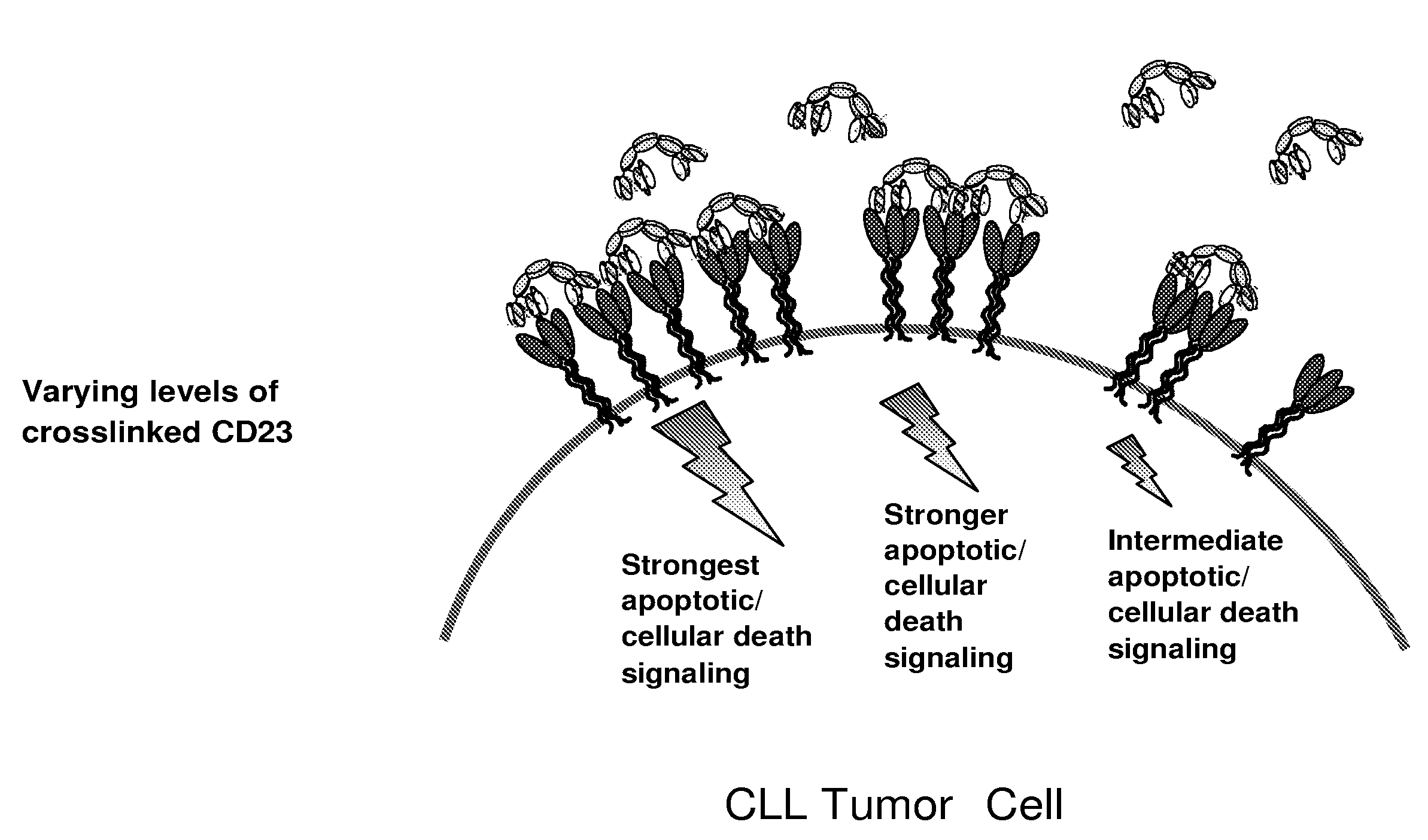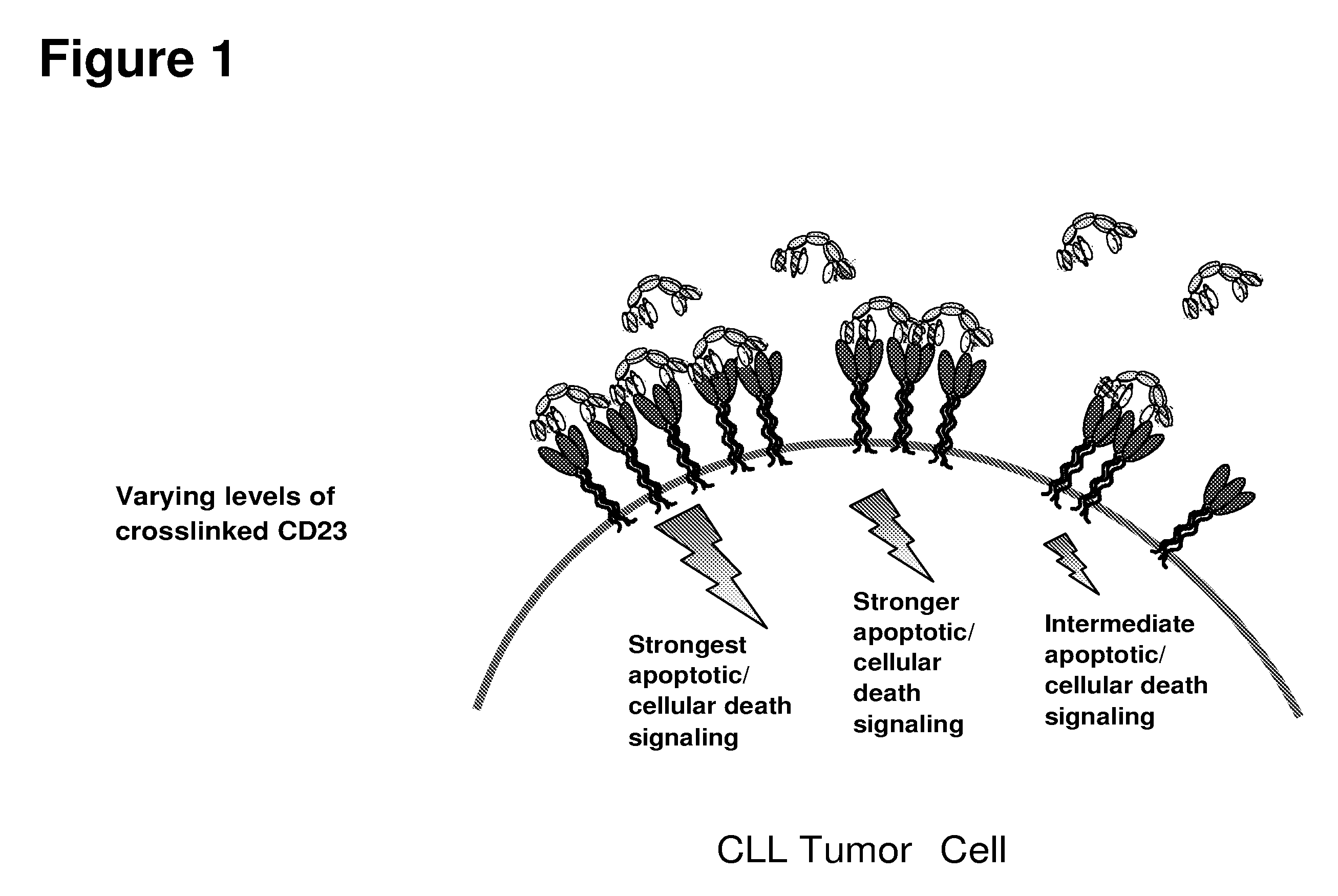Cd23 binding molecules and methods of use thereof
a technology of cd23 and binding molecules, which is applied in the field of cd23 binding molecules, can solve the problems of unsuitability for scale-up production, difficulty in protein purification, and low yield, and achieve the effects of improving potency, efficacy, and/or stability
- Summary
- Abstract
- Description
- Claims
- Application Information
AI Technical Summary
Benefits of technology
Problems solved by technology
Method used
Image
Examples
example 1
Preparation of a PRIMATIZED® p5E8 Tetravalent Antibody Comprising a Conventional p5E8 scFv
[0362]DNA and amino acid sequences for both the heavy chain PRIMATIZED® p5E8 scFv fusion protein and light chain PRIMATIZED® p5E8 are shown in FIGS. 3 and 4, respectively. The conventional PRIMATIZED® p5E8 scFv used for constructing the tetravalent antibody is comprised of p5E8 VL and VH region sequences tethered by a short linker in the VL→(Gly4Ser)3 linker→VH orientation. DNA and amino acid sequences of the conventional p5E8 VL / VH scFv are shown in FIGS. 5A and 5B, respectively. Correct sequences were confirmed by DNA sequence analysis. Plasmid DNA was used to transform CHO DG44 cells for stable production of antibody protein.
example 2
Preparation of PRIMATIZED® p5E8 scFv and Fab Proteins
[0363]p5E8 scFvs in the orientation VL→(Gly4Ser)3 linker→VH (VL / VH, FIGS. 5A and 5B) and VH→(Gly4Ser)3 linker→VL (VH / VL, FIGS. 6A and 6B) were subcloned by PCR amplification from plasmids described in U.S. Patent Application 20050163782. Oligonucleotides used in the construction are shown in Table 1. p5E8 scFv (VL / VH) was constructed by PCR using the forward primer P5E8-VL01F which contains 29 bases encoding part of the gpIII leader sequence followed by 15 bases of sequence complementary to the p5E8 N-terminal light variable domain gene and the reverse primer, P5E8-VH01R, which contains 15 bases of sequence complementary to the p5E8 C-terminal heavy variable domain followed by a unique adjacent Sal I endonuclease site (endonuclease site is underlined). Similarly, p5E8 scFv (VH / VL) was constructed by PCR using the forward primer P5E8-VH01F which contains 29 bases encoding part of the gpIII leader sequence followed by 18 bases of se...
example 3
Thermal Stability of Conventional p5E8 scFv Antibodies
[0366]A thermal challenge assay described in U.S. patent application Ser. No. 11 / 725,970 was employed as a stability screen to determine the temperature at which 50% of the p5E8 (VL / VH) and p5E8 (VH / VL) scFvs molecules retain their antigen binding activity following a thermal challenge event.
[0367]E. coli strain W3110 (ATCC, Manassas, Va. Cat. #27325) was transformed with plasmids encoding p5E8 (VL / VH) and p5E8 (VH / VL) scFvs under the control of an inducible ara C promoter. Transformants were grown overnight in expression media consisting of SB (Teknova, Half Moon Bay, Calif. Cat. #S0140) supplemented with 0.6% glycine, 0.6% Triton X100, 0.02% arabinose, and 50 μg / ml carbenicillin at 30° C. Bacteria was pelleted by centrifugation and supernatants harvested for further treatment.
[0368]After thermal challenge, the aggregated material was removed by centrifugation and soluble scFv samples remaining in the treated, cleared supernatan...
PUM
| Property | Measurement | Unit |
|---|---|---|
| Mass | aaaaa | aaaaa |
| Mass | aaaaa | aaaaa |
| Density | aaaaa | aaaaa |
Abstract
Description
Claims
Application Information
 Login to View More
Login to View More - R&D
- Intellectual Property
- Life Sciences
- Materials
- Tech Scout
- Unparalleled Data Quality
- Higher Quality Content
- 60% Fewer Hallucinations
Browse by: Latest US Patents, China's latest patents, Technical Efficacy Thesaurus, Application Domain, Technology Topic, Popular Technical Reports.
© 2025 PatSnap. All rights reserved.Legal|Privacy policy|Modern Slavery Act Transparency Statement|Sitemap|About US| Contact US: help@patsnap.com



